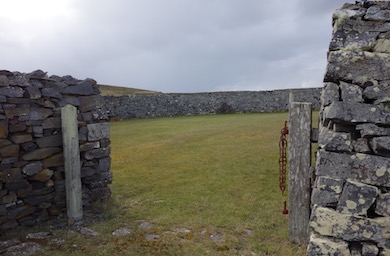The Falkland Islands have a rich history embracing geological features, some famous visitors, historic buildings, maritime adventures, farming traditions and of course the events of the 1982 war. There is much to discover.
A naturalist's wonder
Rocks and fossils tell a fascinating story dating back one billion years; the most interesting and unusual feature being stone runs, rivers of rock cascading out of the mountains to the valley floor. Stone runs are found on East Falkland, easy to view from the roadside but at their most spectacular when seen from above! The naturalist Charles Darwin spent longer on the Falklands than the Galapagos Islands and his world-changing theories were based on his discovery of a wolf-like animal called the Warrah, sadly now extinct, and his fossil-finds.
Early settlers
 Stone corrals and turf walls were constructed by early settlers in the Islands and splendid examples can still be explored at Darwin and Stanley. Stone buildings survive at a number of locations, though later houses were built from wood due to the ease and cost of importation of light-weight materials.
Stone corrals and turf walls were constructed by early settlers in the Islands and splendid examples can still be explored at Darwin and Stanley. Stone buildings survive at a number of locations, though later houses were built from wood due to the ease and cost of importation of light-weight materials.
Horses played an important role in Falklands’ life for many years. They were introduced to the Islands in the mid-18th century and became the main mode of transport. In recent years, Government officials would ride from Stanley on business, doctors and the clergy would make their rounds on horseback. The use of horses decreased after 1983 when many large farms were broken up and new farmers brought in motorbikes and quadbikes but horse racing continues. It has featured for over a century in the Falklands’ social calendar. Races are short but highly competitive. Today there are three major events, two held in Stanley and one at the East Falkland Camp Sports.
Historic buildings
Pioneer Cottages on Drury Street and Pioneer Row are now mainly privately-owned houses but can be seen and photographed on a guided or self-guided tour of the Islands’ capital. Cartmell Cottage, on Pioneer Row, is owned by the Falkland Islands Museum and National Trust and open to visitors. It depicts life at various points in time through donated exhibits.
Christ Church Cathedral, with the Whalebone Arch alongside, create a photographic tableau and iconic view on the Stanley shoreline. Consecrated in 1892 by the Bishop of South America, the Anglican Cathedral today hosts important annual memorial events and welcomes all visitors to weekly services or just to look around and learn more about the historic building and its importance to the Islands. There are many attractive features including beautiful stained glass windows, a working pipe organ, intricate carvings and hand-crafted kneelers. Queen Victoria reputedly gave £30 towards the construction of the building which is made from local stone and London brick.
Maritime tradition
.jpg) Over one hundred ships have been wrecked off Falkland shores, due to gales and hidden rocks. The Lady Elizabeth survives at the eastern end of Stanley harbour and remains of other vessels can be found elsewhere around the Islands. A mizzen mast from the SS Great Britain is displayed on Victory Green in Stanley. The steam ship was the first of its kind to be built, screw propelled and from iron, in 1843 in Bristol (UK) by Isambard Kingdom Brunel. Badly damaged in a gale, the vessel lay for many years in the outer harbour of Stanley before being towed back to Bristol in 1970 for restoration.
Over one hundred ships have been wrecked off Falkland shores, due to gales and hidden rocks. The Lady Elizabeth survives at the eastern end of Stanley harbour and remains of other vessels can be found elsewhere around the Islands. A mizzen mast from the SS Great Britain is displayed on Victory Green in Stanley. The steam ship was the first of its kind to be built, screw propelled and from iron, in 1843 in Bristol (UK) by Isambard Kingdom Brunel. Badly damaged in a gale, the vessel lay for many years in the outer harbour of Stanley before being towed back to Bristol in 1970 for restoration.
Artefacts from some of the ships and interesting anecdotes are in the Historic Dockyard Museum. Cape Pembroke Lighthouse, at the extreme eastern end of the Stanley peninsula is another reminder of times past.
Farm life
Farming heritage is on display at the excellent little museum at North Arm as well as through memorabilia at the Historic Dockyard Museum. Travel around the Islands, in summer months particularly, gives an insight into continuing, daily farm life with opportunities to view sheep shearing and through conversations with farm workers.
The 1982 Conflict and 40th Anniversary Commemorations
War was never officially declared so the word ‘conflict’ is most frequently used. The events that took place in 1982 began with ‘Operation Rosario’, the landing of Argentine forces in Stanley on 2nd April. Troops were dispatched from the UK to regain the Falklands for the Islanders who, in the words of then Prime Minister Margaret Thatcher, “are few in number, but they have the right to live in peace, to choose their own way of life and to determine their own allegiance”. Fierce fighting followed on land, in the air and at sea. General Mario Mendendez surrended to Major General Jeremy Moore 74 days later on 14th June.
Every year Islanders hold a service on 14th June at Christ Church Cathedral, followed by remembrance around the Liberation Memorial in Stanley. Other services are held around the Islands in the lead up to 14th June to commemorate key battles and also on Liberation Day itself.
2022 marks the 40th anniversary for which a programme of events thanked the veterans of the conflict and celebrated the progress since made. In every key year of commemoration, large groups of veterans have been made welcome into Islanders’ homes and enjoyed the hospitality and friendship extended to them. Veterans are always welcome, at any time.
Visitors can learn more of the history of 1982 at various locations around the Islands, including an excellent exhibition and spoken memories in the Historic Dockyard Museum, Stanley.

.png)



 Stone corrals and turf walls were constructed by early settlers in the Islands and splendid examples can still be explored at Darwin and Stanley. Stone buildings survive at a number of locations, though later houses were built from wood due to the ease and cost of importation of light-weight materials.
Stone corrals and turf walls were constructed by early settlers in the Islands and splendid examples can still be explored at Darwin and Stanley. Stone buildings survive at a number of locations, though later houses were built from wood due to the ease and cost of importation of light-weight materials..jpg) Over one hundred ships have been wrecked off Falkland shores, due to gales and hidden rocks. The
Over one hundred ships have been wrecked off Falkland shores, due to gales and hidden rocks. The  Prev
Prev




